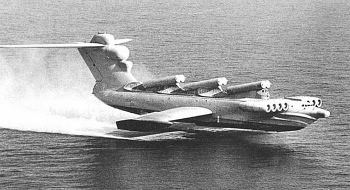Name Rostislav Alexeyev | Role Designer | |
 | ||
Aircraft designed | ||
rostislav alexeyev man two verses
Rostislav Evgenievich Alexeyev (Russian: Ростисла́в Евге́ньевич Алексе́ев; born December 18, 1916 in Novozybkov, Chernigov Governorate (now Bryansk Oblast), Russian Empire; died February 9, 1980 in Gorky (now Nizhny Novgorod), USSR) was a designer of highspeed shipbuilding who invented and designed the world's first ekranoplan vehicles. His work has been compared to that of A.N. Tupolev in aviation and S.P. Korolev in space flight.
Contents
Памяти выдающегося конструктора - кораблестроителя Ростислава АЛЕКСЕЕВА
Hydrofoil ships

Alexeyev was responsible for putting into practice high speed ships on the so-called low submerged underwater wings, the most popular ones being passenger ships Raketa, Volga, Meteor, Kometa, and Burevestnik, with passenger capacity up to 150 persons and cruising speed up to 100 km/h (62 mph; 54 kn).
Ekranoplans
Alexeyev revolutionised the shipbuilding industry (though in secrecy) by inventing crafts that use ground effect, whereby a wing traveling close to the ground is provided with a better lift-drag ratio - thereby enabling a combination of greater aircraft weight for less power and/or enhanced fuel economy.
In his career working for the military he created a ten engine ekranoplan referred to at the time by American intelligence as "the Caspian sea monster". The KM or "korabl-maket", the largest ekranoplan ever built, was one of the first very successful vehicles designed by Alexeyev and built by his Central Hydrofoil Design Bureau. The KM was intended as a test platform to examine the possibilities of the "Wing In Ground" (WIG) effect.
The KM, powered by eight Dobrynin VD-7 turbojets on the front of the fuselage, and two on the tail for extra thrust during take-off, first took to the air in October 1966. During its extensive test career, it was continually modified. The wingspan was altered to between 32m and 40m, and the length varied from 92m to 106m.
The KM crashed in 1980, apparently due to the pilot ill-advisedly attempting to take off without giving it full throttle. An attempt to recover the leviathan from the depths was thwarted by its vast weight. While the KM programme was ongoing, Alexeyev began work on a medium-sized ekranoplan suitable for military transportation duties. Dubbed A-90 "Orlyonok" ("Eaglet"), the 140 tonne, 58 metre long aircraft had its maiden flight in 1972. The A-90 boasted two turbojets and one turboprop engine which propelled it to a speed of 400 km/h for 1,500 km at a cruise altitude of 5–10 m.
Death & legacy
Following the crash of one A-90 Orlyonok during testing, Soviet military heads used the incident as an excuse to remove Alexeyev as chief designer. He spent the rest of his life away from scientific work, concentrating mostly on sports. He died in 1980.
After the fall of the Soviet Union, the details of Alexeyev's work became known to the public and generated a lot of interest from around the world. He is now generally considered as the father of ground effect vehicle design.
